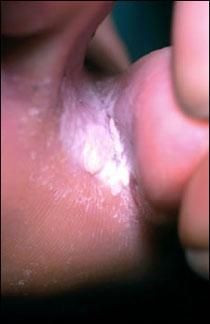This topic takes on average 55 minutes to read.
There are a number of interactive features in this resource:
 Biology
Biology
Not all diseases are deadly, or even serious. What’s more, not all infectious diseases are caused by bacteria or viruses.
Athlete's foot, or tinea pedis, is a skin infection caused by a fungus that can affect the scalp, skin, fingers, toe nails or foot and for most people it is an inconvenience more than anything else. The causative organisms are a group of fungi known as Dermatophytes. The fungi are all very infectious, and they particularly like warm moist areas of your body. The more sweat the better!
When a dermatophyte fungus affects your feet– you have athlete’s foot. Athlete's foot infections are spread relatively easily from person to person by skin contact. It can also be transmitted by contact with material that has been in contact with the skin of an infected person – such as towels, flooring such as carpets etc.

Dermatophyte fungal infection causing athlete's foot, or tinea pedis, between toes.
Athlete's foot is very common, because the area between your toes is very warm and moist (sweaty feet!) and the skin is very soft. The fungus produces a scaling or cracking of the skin, especially between the toes. This can be itchy or – when the skin falls off to leave raw tissue beneath it – very sore.
The most common way to treat athlete’s foot is to use antifungal creams which are rubbed into the infected skin or powders that can be applied directly to the affected areas. You can easily buy these and treat yourself. If you have a really stubborn infection your doctor may treat you with a prescribed fungicide that can be taken as tablets. As they can have serious side effects, they are only used when it is really necessary.
To prevent the spread of athlete’s foot, don’t share towels, or walk barefoot in communal changing rooms or another shared spaces. Although athlete’s foot is not at all serious, some fungal diseases attack the valves of your heart or get into your lungs or your brain. They are very dangerous indeed, and can be fatal particularly in the elderly or people who are already ill with diseases such as cancer